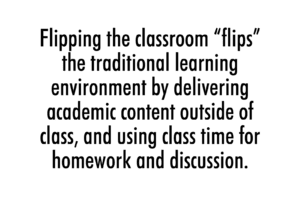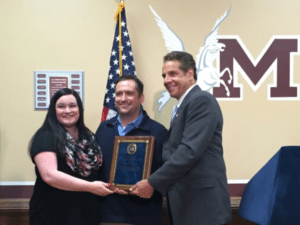I met Adam Norris 10 years ago when he began his teaching career as a substitute teacher at my high school. By the time I graduated, he became my U.S. history teacher, student government advisor, swim coach, and even wrote my letters of recommendation to college. I’d say he was my favorite teacher, but that would be an understatement— Mr. Norris (or Adam as he prefers to be called these days) was everyone’s favorite teacher.
That’s why I was hardly surprised when news broke that the Governor paid a visit to my alma mater to present Adam with the Empire State Excellence in Teaching Award. But that’s not the only recognition he’s received lately. Adam was also named one of 10 semi-finalists for the 2016 New York State Teacher of the Year and recognized as one of 25 2015 Teachers of Merit by Buffalo’s Business First magazine.
Why has Adam received so much praise and recognition lately? The short answer is: he’s making a profound impact on his students with an innovative learning technique called “flipping the classroom.”
Flipping the classroom is a student-centered instructional technique that “flips” the traditional learning environment by delivering academic content to students outside of class and using class time for homework and discussion. This technique often incorporates blended learning, meaning academic content is presented at least in part by digital and web-based online media, such as online lectures or videos.
This flipped classroom concept isn’t new; however, Adam does deserve credit for mastering the blended learning technique that’s working for his students.*
Adam teaches Advanced Placement U.S. History (APUSH) and his students’ AP exam scores are the highest the school has ever seen. In fact, his students scored above the national average the last four years, averaging above the 3.0 minimum to receive college credit. This is a big deal for my school, where nearly half of the student body is economically disadvantaged.
 I reached out to Adam to reconnect and learn more about how he flips his classroom. Adam creates videos of himself talking through a PowerPoint presentation for every APUSH textbook chapter. The video replaces a traditional lecture, so students must watch the video before class to gain exposure to the academic content. In addition to posting the videos online, Adam burns DVDs of the videos and provides portable DVD players to students who might not have access to the internet or a computer outside of school. Moreover, students are expected to fill out a guided notes handout as they watch the video and come to class with questions. Class time, then, is used for answering questions and engaging in deeper discussion and analysis.
I reached out to Adam to reconnect and learn more about how he flips his classroom. Adam creates videos of himself talking through a PowerPoint presentation for every APUSH textbook chapter. The video replaces a traditional lecture, so students must watch the video before class to gain exposure to the academic content. In addition to posting the videos online, Adam burns DVDs of the videos and provides portable DVD players to students who might not have access to the internet or a computer outside of school. Moreover, students are expected to fill out a guided notes handout as they watch the video and come to class with questions. Class time, then, is used for answering questions and engaging in deeper discussion and analysis.
Here’s why it works:
Absent students are less likely to fall behind
Prior to the videos, when a student missed class, s/he missed an entire chapter of APUSH material, making it difficult to stay on track. According to Adam, the videos are “not going to replace teaching,” but they do ensure absent students don’t automatically miss the bulk of academic content and fall behind.
Students are able to prepare for class anytime, anywhere at their own pace
As long as students prepare for class, it doesn’t matter when or where they do it. Students can watch a video on the bus ride to a football game or before bed. The technique also allows students to digest the material at their own pace. Adam noted that a 10 or 15-minute video usually takes his students anywhere between 20 and 30 minutes to watch and take notes on because students will pause or rewind the video where they have questions or need the information repeated.
It frees up class time for the hard work
Since students are exposed to academic content before they step inside the classroom, Adam “can spend a lot more time on skills than content” during class. According to Adam, a 10-minute video replaces 1-3 days of notetaking because he no longer frequently pauses his lecture to answer questions. When every student arrives to class with a baseline of knowledge, that frees up time for clarifying questions, engaging in more critical discussion, analyzing historical documents and texts, and refining other skills necessary for excelling on the exam.
The delivery is informative and engaging
Adam doesn’t just record himself reading off the slides of a PowerPoint; his style is engaging and humorous so it doesn’t feel like you’re doing homework as you watch a video. “You have to be entertaining,” Adam told me, and he’s definitely not afraid to get silly to capture his students’ attention or drive a point home. To see what I mean, here’s a video on President Lyndon B. Johnson, where Adam gives his dog Pugsley the “Johnson Treatment.”
Content is reinforced in various ways
According to Adam, “students just need extra reinforcement sometimes” in order to remember a fact or understand a concept. The videos and guided notes provide another, different layer of exposure to the material in addition to the textbook, class time, and projects. Also, the guided notes help hold students accountable for their learning, ensuring they are actively engaged while watching a video. For an example of this, see the guided notes handout for the LBJ video above.
“If you invest in students, they will pay you back”
Flipping the classroom is a lot of work. Adam told me that, from start to finish, a 10-minute video is about three hours of work between making the PowerPoint, recording himself, and editing it down to the final product. Although he has created hundreds of videos and has become “obsessed” with analyzing the APUSH curriculum and exams, Adam isn’t everybody’s favorite teacher solely because of the hard work he puts in to creating videos. He also holds APUSH study sessions on evenings and Saturdays where he provides dinner for his students. He lives in the community and frequently chaperones school functions and attends school events and ceremonies. Adam told me, “If your students aren’t succeeding, it’s on you [the teacher]. The classes I did the best in were the ones where the teacher cared.” That’s what worked for him and that’s what works for his students.
*Adam’s technique isn’t only working for his students, but thousands of students (and teachers) across New York State, the country, and abroad. Adam’s content is publicly available for free on his website, and many have written to him to show their appreciation for the valuable resource. Adam also has thousands of followers on Twitter and nearly 45K subscribers and more than 8M views on YouTube.
Jenna Tomasello is a Policy Associate at the American Youth Policy Forum.








